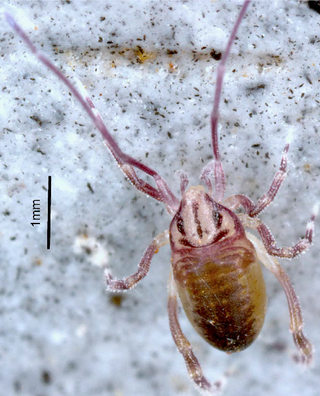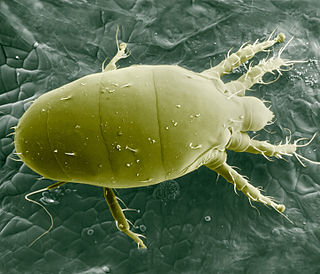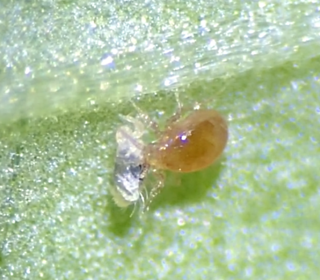
Mites are small arachnids. Mites span two large orders of arachnids, the Acariformes and the Parasitiformes, which were historically grouped together in the subclass Acari. However, most recent genetic analyses do not recover the two as each other's closest relative within Arachnida, rendering the group non-monophyletic. Most mites are tiny, less than 1 mm (0.04 in) in length, and have a simple, unsegmented body plan. The small size of most species makes them easily overlooked; some species live in water, many live in soil as decomposers, others live on plants, sometimes creating galls, while others are predators or parasites. This last type includes the commercially destructive Varroa parasite of honey bees, as well as scabies mites of humans. Most species are harmless to humans, but a few are associated with allergies or may transmit diseases.

Parasitiformes are a superorder of Arachnids, constituting one of the two major groups of mites, alongside Acariformes. Parasitiformes has, at times, been classified at the rank of order or suborder.

Opilioacaridae is the sole family of mites in the order Opilioacarida, made up of about 13 genera. The mites of this family are rare, large mites, and are widely considered primitive, as they retain six pairs of eyes, and abdominal segmentation. They have historically been considered separate from other mites belonging to Acariformes and Parasitiformes, but are now generally considered a subgroup of Parasitiformes based on molecular phylogenetics.

The peacock mites of the genus Tuckerella are a significant herbivorous pest in the tropics, for example on citrus fruit. Other species dwell in grasses, possibly as root feeders.

The broad mite, Polyphagotarsonemus latus, is a microscopic species of mite found on many species of plants, spanning 60 families including important agricultural species such as cotton, soybean, blackberries, strawberries, peppers, and other fruits. Broad mites are also currently affecting cannabis plants, as the industry matures with legalization. The mites are found in many areas worldwide and are major greenhouse pests.

The Phytoseiidae are a family of mites which feed on thrips and other mite species. They are often used as a biological control agent for managing mite pests. Because of their usefulness as biological control agents, interest in Phytoseiidae has steadily increased over the past century. Public awareness of the biological control potential of invertebrates has been growing, though mainly in the US and Europe. In 1950, there were 34 known species. Today, there are 2,731 documented species organized in 90 genera and three subfamilies.

Amblyseius is a large genus of predatory mites belonging to the family Phytoseiidae. Many members of this genus feed on other mites such as red spider mites, and also on thrips. Several species are popular as biological control agents to control these pests.
Amblyseius tsugawai is a species of predatory mite belonging to the family Phytoseiidae. This oval mite, less than 0.5 mm in length, is only known from apple trees on Honshū, Japan. It is very similar to congeners found outside Japan but can be distinguished by details of the setation on the fourth pair of legs.
Amblyseius orientalis is a species of predatory mite belonging to the family Phytoseiidae. This oval, greyish white mite is very small; the female is around 380 μm in length and the male is even smaller at around 280 μm. Both sexes are notable for the very long setae on the margins of the body and on the fourth pair of legs. As with many of these often confusingly similar mites, the shape of the sclerotized body shields is important in identification.

Dermanyssoidea is a superfamily of mites, including most of the mites which parasitise vertebrates.
Psylloglyphus is a genus of mites in the family Winterschmidtiidae.
Amblyseius alpinia is a species of mite in the Phytoseiidae family. It is endemic to Taiwan.

Rhinonyssidae is a family of mites in the order Mesostigmata. There are about 16 genera and at least 460 described species in Rhinonyssidae.
Euseius inouei is a species of mite in the family Phytoseiidae originally observed by Shozo Ehara and Gilberto Moraes in Uruguay in 1998. It is named in honor of Dr. Kouichi Inoue of the Instituto Nacional de Investigacion Agropecuaria (INIA) located within Colonia Gestido in the Salto Grande, Uruguay.
Neoseiulus californicus is a predatory mite that feeds on Tetranychid mites. This species was first described on lemons from California under the name Typhlodromus californicus in 1954.

Neoseiulus cucumeris, the cucumeris mite, is a species of predatory mite in the family Phytoseiidae. It is used in biological pest control of western flower thrips in cucumber and some other greenhouse crops.
Typhlodromips swirskii, the Swirski mite, is a species of predatory mite in the family Phytoseiidae. It is used in biological pest control of western flower thrips in greenhouse or indoor grown crops.
Charletonia is a genus of mites belonging to the family Erythraeidae.

Wolfgang Siegfried Karg (1927–2016) was an East German entomologist who specialised in mites (Acari).











